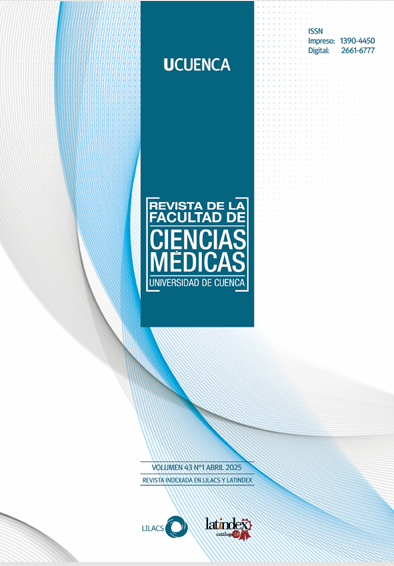Relationship between aortic clamping time and frequency of new-onset atrial fibrillation in patients undergoing aortic valve replacement
DOI:
https://doi.org/10.18537/RFCM.43.01.03Keywords:
atrial fibrillation, arrhythmias cardiac, aortic valve stenosisAbstract
Introduction: postoperative atrial fibrillation (POAF) is a common and costly complication of cardiac surgery. It usually occurs between the second and fourth postoperative day. Determination of the relationship between aortic pressure retention time (APT) and the incidence of POAF in patients after aortic valve replacement is of critical importance.
Objective: to analyze the relationship between intraoperative APT and the occurrence of new-onset atrial fibrillation in patients undergoing this type of surgery.
Methodology: a retrospective cohort study of 117 patients divided into two groups was performed at the José Carrasco Arteaga Hospital. Sociodemographic and clinical data were collected: diabetes mellitus, hypertension, heart disease, COPD, CKD, toxic habits, postoperative amiodarone use, age, sex, weight, height, BMI, incidence of FAPO and TPA (in minutes). Descriptive and analytical statistical analysis was performed using cross-tabulations (Chi-Square) and relative risk (RR).
Results: an ATP longer than 90 minutes was significantly associated with an increased frequency of POAF. The 47.1% of patients with ATP 60-89 minutes and 52.9% of those with ATP 90-119 minutes had this complication (RR 3.121; CI al 95%,1.830 5.322; p<0.0001).
Conclusions: prolonged ATP is a risk factor for the development of POAF in valve replacement surgery for severe aortic stenosis. It is recommended to implement strategies to shorten this time and reduce postoperative complications.
Downloads
Published
Issue
Section
License
Copyright (c) 2025 Javier Arturo López Rodríguez, Andrea Ximena Gómez Ayora , Sonia Catalina Rivera González; Mateo Javier López Rivera

This work is licensed under a Creative Commons Attribution-NonCommercial-ShareAlike 4.0 International License.
Copyright © Autors.

You are free to:
 |
Share — copy and redistribute the material in any medium or format |
 |
Adapt — remix, transform, and build upon the material for any purpose, even commercially. |
Under the following conditions:
 |
Attribution — You must give appropriate credit, provide a link to the licence, and indicate if changes were made. You may do so in any reasonable manner, but not in any way that suggests the licenser endorses you or your use. |
| NonCommercial — You may not use the material for commercial purposes. | |
| ShareAlike — If you remix, transform, or build upon the material, you must distribute your contributions under the same license as the original. |
| No additional restrictions — You may not apply legal terms or technological measures that legally restrict others from doing anything the licence permits. |






